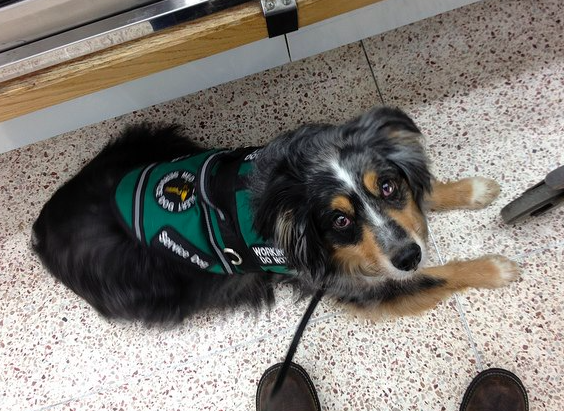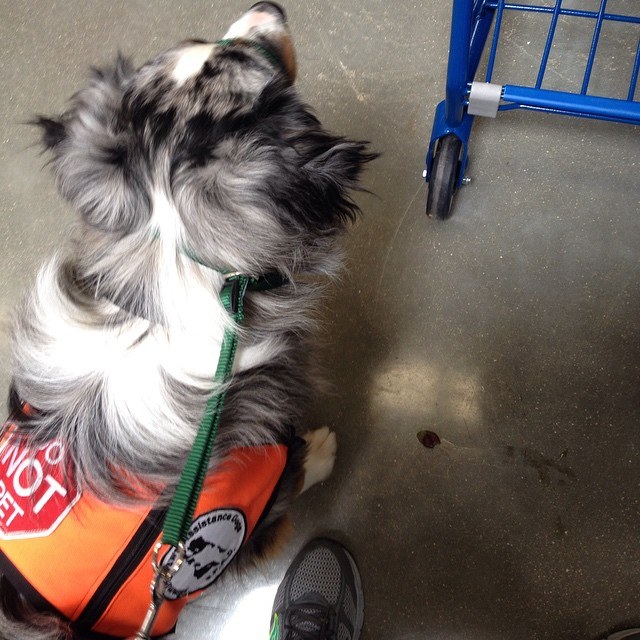They see his fur first, then they see his face.
The awkward smiles start. The “ooos” and “aws” follow.
Then they begin to speak to him in a higher-pitched voice. Parents point him out to their uninterested children, saying, “Look at the doggie!” As if they had never seen a dog before.
Some even try to pet him without asking.
Then you have the individuals who scream (literally) when they see him.
None of them really notice the individual on the other end of the leash.
I hold my hand up and say, “Please don’t. He’s working.” They suddenly notice me and give me a look of shock, disdain or repulsion. Some even become combative because I don’t want them speaking to or petting my service dog.

This is a normal day in the life of a service dog handler. People will randomly come to you and try to interact with your dog. They unknowingly or don’t care that by distracting the dog, they are putting the handler in immediate danger. If you see a service dog team in a public place, they are most likely there for the same reason as you. Service dog handlers do not allot the extra time that is needed to allow everyone to say hello to their dog. Many of us just want to get what we need done and go on with our day.
Service dogs are legally medical equipment under federal and state laws. A service dog goes through 1.5 to 2.5 years of intense and specific training in order to mitigate their handler’s disability. You must be disabled in order to utilize a service dog. In many states, they fall under the white cane law. While they are an optional piece of medical equipment, they are helpful in some cases. Emotional support animals and therapy dogs are not service dogs and are not covered under the Americans with Disabilities Act. And no matter how much you pay for an ID or vest on a website, it does not make your animal a service animal!
Service dogs are medical equipment when they are working. They need to pay attention to their handler and be able to perform the tasks they have been trained to. Tasks are based on the handler’s needs, not wants. Legitimate tasks include opening and closing doors/cabinets, retrieving dropped or named items, guide work, pulling a wheelchair, blood glucose changes detection, deep pressure therapy, etc. “Just being there,” “cuddles/comfort” and tethering a child to a dog are not tasks. Service dogs must be proficient in advanced obedience, public access training and task training. These dogs cost thousands of dollars to train and maintain. They can range from $10,000 to $50,000 to train. Even owner training is expensive. I have about $25,000 in my current service dog and $9,000 in my service dog in training.

These dogs are not pets under the law. They do get to enjoy life and have time off. Many handlers participate in extracurricular activities such as obedience competitions, agility (there are many videos of handlers in wheelchairs participating in this sport), rally-o, etc. Service dogs must be in tip-top shape when working. They must be clean and healthy. In my experience, it is frowned upon in the service dog community to work a dog with a disability of their own. Service dogs rely heavily on their senses (sight, hearing, smell and at times touch) in order to work and assist their handlers appropriately. So, when you distract a service dog, they are no longer able to perform the tasks they need to.
So next time you see a service dog team, please do not make any sounds toward the dog and handler and do not try to pet a working dog. It is rude and very dangerous for the handler if you do. You should also never touch an animal you don’t personally know or don’t have permission to touch. We are not a walking petting zoo. Please respect us as a team and allow us to go on with our day.
For more information about service animals:
- Frequently Asked Questions About Service Animals and the ADA
- U.S. Department of Justice: Service Animals
- Service Dog Central
Disclaimer from the author: The breed shown in this article is not normally trained for service dog work due to their natural instincts. The author of the article has over 10 years of canine training experience and understands canine body language and behavior. Choose the dog breed based on your disability(ies) and your needs, not on the look of the dog. The dogs in the article were chosen based on the author’s needs, not looks. This article does not back any trainers or organizations; all information provided is to educate about service dogs.
Follow this journey on Liz’s blog.
